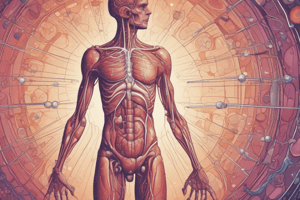Podcast
Questions and Answers
What is the function of barrier defenses in the immune system?
What is the function of barrier defenses in the immune system?
- To provide a rapid and specific immune response
- To prevent pathogenic invasion into the body tissues instantaneously (correct)
- To control immune responses primarily through white blood cells
- To involve various specialized cells and soluble factors
Which immune response is described as slower but more specific and effective?
Which immune response is described as slower but more specific and effective?
- Immune response involving hematopoietic stem cells
- Adaptive immune response (correct)
- Barrier defense immune response
- Rapid innate immune response
Where do cells of the blood involved in the immune response primarily arise from?
Where do cells of the blood involved in the immune response primarily arise from?
- Bone marrow (correct)
- Spleen
- Liver
- Kidney
Which cells help control immune responses in the adaptive immune response?
Which cells help control immune responses in the adaptive immune response?
What is the main function of hematopoietic stem cells in the immune system?
What is the main function of hematopoietic stem cells in the immune system?
Which phase of immune function involves a variety of specialized cells and soluble factors but is rapid and nonspecific?
Which phase of immune function involves a variety of specialized cells and soluble factors but is rapid and nonspecific?
What is the primary function of B cells?
What is the primary function of B cells?
Where do T cells mature?
Where do T cells mature?
What is the main function of natural killer cells?
What is the main function of natural killer cells?
Which type of lymphocyte helps mediate immune responses against parasites and intracellular pathogens?
Which type of lymphocyte helps mediate immune responses against parasites and intracellular pathogens?
What distinguishes B cells from T cells?
What distinguishes B cells from T cells?
What is the role of T cells in the adaptive immune response?
What is the role of T cells in the adaptive immune response?
Which lymphocyte functions by secreting antibodies after activation by antigens?
Which lymphocyte functions by secreting antibodies after activation by antigens?
Where does the B cell undergo nearly all of its development?
Where does the B cell undergo nearly all of its development?
In the embryo, where are blood cells primarily made?
In the embryo, where are blood cells primarily made?
Which organ is responsible for taking over most hematopoietic functions as development proceeds?
Which organ is responsible for taking over most hematopoietic functions as development proceeds?
What is the primary function of the red bone marrow?
What is the primary function of the red bone marrow?
Where does the immature T cell, or thymocyte, leave to mature largely?
Where does the immature T cell, or thymocyte, leave to mature largely?
What separates and divides the thymus gland into lobules?
What separates and divides the thymus gland into lobules?
Where does a thymocyte primarily undergo maturation?
Where does a thymocyte primarily undergo maturation?
What is the primary function of yellow bone marrow?
What is the primary function of yellow bone marrow?
In the embryo, where are blood cells initially made?
In the embryo, where are blood cells initially made?
Where do B cells undergo nearly all of their development?
Where do B cells undergo nearly all of their development?
What separates and divides the thymus gland into lobules?
What separates and divides the thymus gland into lobules?
Which organ holds the primary responsibility for hematopoiesis in most cases?
Which organ holds the primary responsibility for hematopoiesis in most cases?
Flashcards are hidden until you start studying
Study Notes
The Immune System
- The immune system is a complex collection of barriers, cells, and soluble proteins that interact and communicate with each other.
- The modern model of immune function is organized into three phases based on the timing of their effects:
- Barrier defenses (instantaneous)
- Innate immune response (rapid but nonspecific)
- Adaptive immune response (slower but more specific and effective)
Development of Blood Cells
- All blood cells, including those involved in the immune response, arise in the bone marrow via various differentiation pathways from hematopoietic stem cells.
- Hematopoietic stem cells are present throughout adulthood and allow for the continuous differentiation of blood cells to replace those lost to age or function.
- There are three classes of blood cells based on function:
- Phagocytic cells (ingest pathogens to destroy them)
- Lymphocytes (coordinate adaptive immunity)
- Cells containing cytoplasmic granules (mediate immune responses against parasites and intracellular pathogens)
Lymphocytes
- Lymphocytes are the primary cells of adaptive immune responses.
- There are two basic types of lymphocytes: B cells and T cells.
- B cells mature in red bone marrow, while T cells mature in the thymus gland.
- B cells and T cells are found in many parts of the body, circulating in the bloodstream and lymph, and residing in secondary lymphoid organs (spleen and lymph nodes).
B Cells
- B cells function primarily by producing antibodies.
- An antibody is a protein that binds specifically to pathogen-associated molecules (antigens).
- Activated B cells differentiate into plasma cells, which secrete a soluble form of their surface antibodies.
T Cells
- T cells do not secrete antibody but perform a variety of functions in the adaptive immune response.
- Different T cell types have the ability to either secrete soluble factors that communicate with other cells of the adaptive immune response or destroy cells infected with intracellular pathogens.
Plasma Cells
- Plasma cells are activated B cells that have differentiated in response to antigen binding.
- They secrete soluble antibodies and contain a large amount of cytoplasm packed with protein-synthesizing machinery (rough endoplasmic reticulum).
Natural Killer Cells
- Natural killer (NK) cells are participants in the innate immune response.
- NK cells contain cytotoxic (cell-killing) granules in their extensive cytoplasm.
- They share this mechanism with cytotoxic T cells of the adaptive immune response.
- NK cells are among the body’s first lines of defense against viruses and certain types of cancer.
Lymphocyte Types and Functions
- B lymphocyte: generates diverse antibodies
- T lymphocyte: secretes chemical messengers
- Plasma cell: secretes antibodies
- NK cell: destroys virally infected cells
Development and Maturation of B and T Cells
- Understanding the differentiation and development of B and T cells is critical to the understanding of the adaptive immune response.
- The primary lymphoid organs are the bone marrow and thymus gland.
- The lymphoid organs are where lymphocytes mature, proliferate, and are selected, enabling them to attack pathogens without harming the body’s own cells.
Thymus Gland
- The thymus gland is a bilobed organ found in the space between the sternum and the aorta of the heart.
- It is where T cells mature and are selected to attack pathogens without harming the body’s own cells.
Studying That Suits You
Use AI to generate personalized quizzes and flashcards to suit your learning preferences.




